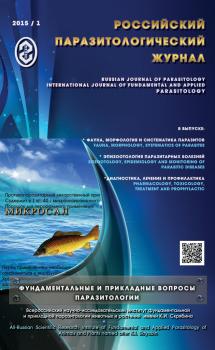Objective of research: Development of methods for the determination of fenbendazole and its metabolites in milk by liquid chromatography coupled with tandem mass spectrometry. Materials and methods: Fenbendazole was administered orally to five cows. Samples of milk were taken on 1, 3, 5 and 10 days of drug application. The research method includes a description of reagents, plates and equipment; mass-spectrometric conditions for analysis of fenbendazole and its metabolites; preparation of the equipment to operation; preparation of eluent solution; preparation of the chromatograph to analysis; determination of chromatographic parameters of standard drug samples; preparation of milk samples to analysis; establishment of parameters of extracts’ chromatography; procedure of calibration of fenbendazole and its metabolites in eluent. Results and discussion: When studying the pharmacokinetics of fenbendazole and its metabolites (sulfone and sulfoxide) in milk, it was found that the maximal concentrations were determined 24 h after drug administration and were 22,6 ng/ml for fenbendazole sulfone, 34,0 ng/ml for fenbendazole sulfoxide and 19,7 ng/ml for fenbendazole. 10 days after treatment, the concentrations of fenbendazole and its metabolites in milk did not exceed permitted values.
milk, fenbendazole, metabolite, sulfoxide, sulfone, pharmacokinetics, liquid chromatography, mass-spectrometry.
Введение
Вигисокс — комплексный антигельминтный препарат с содержанием 8% фенбендазола, 72% никлозамида и вспомогательных веществ. Фенбендазол, входящий в состав препарата, обладает выраженным нематодоцидным и в меньшей степени цестодоцидным и трематодоцидным действиями. Механизм действия его заключается в угнетении фумарат редуктазы, нарушении проницаемости клеточных мембран и нервно-мышечной иннервации, что приводит к гибели гельминта [14, 15]. Установлена высокая эффективность препарата при мониезиозе, диктиокаулезе, стронгилятозах пищеварительного тракта овец, коз и крупного рогатого скота в дозе 60 мг/кг, при трихоцефалезе — 80 мг/кг [1–3].
Для внедрения препарата в ветеринарную практику необходимы сведения по параметрам фармакокинетики и остаточным количествам его действующих веществ в органах и тканях животных, что и явилось целью наших исследований. В связи с тем, что после всасывания фенбендазол быстро метаболизируется в печени до сульфоксида (оксфендазола), обладающего антигельминтным действием, и в дальнейшем до сульфона, то их остаточные количества требуют детекции [8].
1. Arkhipov I.A., Radionov A.V., Belova E.E., Sadov K.M., Arhipova A.I. Anthelmintic efficacy of vigisox at helminthiasis in sheep. Ros. parazitol. zhurnal [Russian Journal of Parasitology], 2010, no. 4, pp. 89-93.
2. Arkhipov I.A., Varlamova A.V., Danilevskaya N.V., Belova E.E., Sadov K.I. Efficacy of vigisox at helminthiasis in young cattle. Ros. parazitol. zhurnal [Russian Journal of Parasitology], 2011, no. 4, pp. 126-129.
3. Arkhipov I.A., Varlamova A.I., Danilevskaya N. V. Methods for the use of vigisox at helminthiasis in ruminants. Ros. parazitol. Zhurnal [Russian Journal of Parasitology], 2013, no. 2, pp. 112-113.
4. Carroll R.J., Ruppert D. Transformation and Weighting in Regression, Chapman and Hall, New York. 1988.
5. Chiap P., Boulanger B., Dewe W. et al. An Analysis of the SFSTP guide on Validation of Chromatographic bioanalytical Methods: Progress and Limitations. J. Pharm. Biomed. Anal., 2003, vol. 32, pp. 753-765.
6. Committee for medicinal products for veterinary use. Fenbendazole (extrapolation to all ruminants). EMEA/MRL/866/03-FINAL/June 2004.
7. Epshtein N.A. Validation of HPLC techniques in pharmaceutical analysis (review). Khimikofarmatsevticheskiy zhurnal [Pharmaceutical Chemistry Journal], 2004, vol. 38, no. 4, pp. 48-56.
8. Ermer J., Miller J. H. McB. Method Validation in Pharmaceutical Analysis. 2006, John Wiley & Sons, p. 418.
9. GOST R ISO 5725-6-2002 Accuracy (trueness and precision) of measurement methods and results.
10. Hartmann C., Smeyers-Verbeke J., Massart D. L., McDowall R. D. Validation on bioanalytical chromatographic methods. J. Pharm. Biomed. Anal., 1998, vol. 17, pp. 193-218.
11. Khamide Dr., Sen´yuva Z., Gilbert Dzh. Prostoe rukovodstvo dlya pol´zovateley po razrabotke i validatsii metodov. Moscow «OOO Torius 77» Publ., 2011. 43 p.12. Marriner S.E., Bogan J.A. Pharmacokinetics of fenbendazole in sheep. Am. J. Vet. Res. - 1981, мol. 42, No 7, pp. 1146-1148.
12. Prichard E., Barwick V. Quality assurance in analytical chemistry. Spb., Publ. «Professiya», 2011. 320 p. (Russ. ed.: Kontrol’ kachestva v analiticheskoj himii)
13. Rew R.S., Fetterer R.H. Mode of action of Antinematodal Drugs. Chemotherapy of parasitic diseases, 1986, pp. 321-334.
14. Senyuva H.Z., Gilbert J. A simple users’ guide to methods of development and validation. (Russ. ed.: Prostoe rukovodstvo dlya pol’zovateley po razrabotke i validatsii metodov). M., Torius 77 Ltd., 2011. 43 p.
15. Van den Bossche H. Chemotherapy of parasitic infections. Nature (London), 1978, vol. 273, pp. 626-630.
16. US Food and Drug Administration. Guidance for industry: Q2B validation of analytical procedures: methodology. Rockville, MD. 1996.





